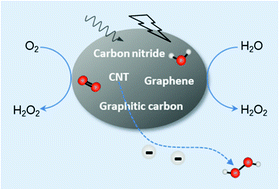Carbon-based materials for photo- and electrocatalytic synthesis of hydrogen peroxide
Abstract
The high demand for hydrogen peroxide (H2O2) has been dominantly supplied by the anthraquinone process for various applications globally, including chemical synthesis and wastewater treatment. However, the centralized manufacturing and intensive energy input and waste output are significant challenges associated with this process. Accordingly, the on-site production of H2O2via electro- and photocatalytic water oxidation and oxygen reduction partially is greener and easier to handle and has recently emerged with extensive research aiming to seek active, selective and stable catalysts. Herein, we review the current status and future perspectives in this field focused on carbon-based catalysts and their hybrids, since they are relatively inexpensive, bio-friendly and flexible for structural modulation. We present state-of-the-art progress, typical strategies for catalyst engineering towards selective and active H2O2 production, discussion on electro- and photochemical mechanisms and H2O2 formation through both reductive and oxidative reaction pathways, and conclude with the key challenges to be overcome. We expect promising developments would be inspired in the near future towards practical decentralized H2O2 production and its direct use.

- This article is part of the themed collections: Advanced Nanomaterials for Energy Conversion and Storage and Recent Review Articles


 Please wait while we load your content...
Please wait while we load your content...